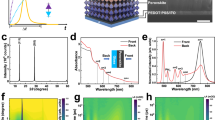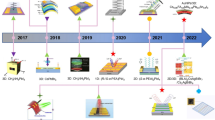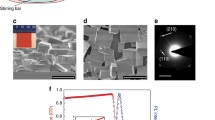Abstract
The integration of optical signal generation and reception into one device—thus allowing a bidirectional optical signal transmission between two identical devices—is of value in the development of miniaturized and integrated optoelectronic devices. However, conventional solution-processable semiconductors have intrinsic material and design limitations that prevent them from being used to create such devices with a high performance. Here we report an efficient solution-processed perovskite diode that is capable of working in both emission and detection modes. The device can be switched between modes by changing the bias direction, and it exhibits light emission with an external quantum efficiency of over 21% and a light detection limit on a subpicowatt scale. The operation speed for both functions can reach tens of megahertz. Benefiting from the small Stokes shift of perovskites, our diodes exhibit a high specific detectivity (more than 2 × 1012 Jones) at its peak emission (~804 nm), which allows an optical signal exchange between two identical diodes. To illustrate the potential of the dual-functional diode, we show that it can be used to create a monolithic pulse sensor and a bidirectional optical communication system.





Similar content being viewed by others
Data availability
The data that support the plots within this paper and other findings of this study are available from the corresponding author upon reasonable request.
References
Shi, Z. et al. Transferrable monolithic iii–nitride photonic circuit for multifunctional optoelectronics. Appl. Phys. Lett. 111, 241104 (2017).
Jiang, Y. et al. Simultaneous light-emitting light-detecting functionality of InGaN/GaN multiple quantum well diodes. IEEE Electron Device Lett. 38, 1684–1687 (2017).
Clark, J. & Lanzani, G. Organic photonics for communications. Nat. Photonics 4, 438–446 (2010).
Klauk, H. Organic Electronics: Materials, Manufacturing and Applications (Wiley, 2006).
Muccini, M. A bright future for organic field-effect transistors. Nat. Mater. 5, 605–613 (2006).
Shirasaki, Y., Supran, G. J., Bawendi, M. G. & Bulović, V. Emergence of colloidal quantum-dot light-emitting technologies. Nat. Photonics 7, 13–23 (2013).
García De Arquer, F. P., Armin, A., Meredith, P. & Sargent, E. H. Solution-processed semiconductors for next-generation photodetectors. Nat. Rev. Mater. 2, 16100 (2017).
Zhang, G. et al. Highly efficient photovoltaic diode based organic ultraviolet photodetector and the strong electroluminescence resulting from pure exciplex emission. Org. Electron. Phys. Mater. Appl. 10, 352–356 (2009).
Ali, F., Periasamy, N., Patankar, M. P. & Narasimhan, K. L. Integrated organic blue LED and visible-blind UV photodetector. J. Phys. Chem. C 115, 2462–2469 (2011).
Yoshino, K. et al. Marked enhancement of photoconductivity and quenching of luminescence in poly(2,5-dialkoxy-p-phenylene vinylene) upon C60 doping. Jpn J. Appl. Phys. 32, L357–L360 (1993).
Mashford, B. S. et al. High-efficiency quantum-dot light-emitting devices with enhanced charge injection. Nat. Photonics 7, 407–412 (2013).
Dai, X. et al. Solution-processed, high-performance light-emitting diodes based on quantum dots. Nature 515, 96–99 (2014).
Oh, N. et al. Double-heterojunction nanorod light-responsive LEDs for display applications. Science 355, 616–619 (2017).
Oertel, D. C., Bawendi, M. G., Arango, A. C. & Bulović, V. Photodetectors based on treated CdSe quantum-dot films. Appl. Phys. Lett. 87, 213505 (2005).
Clifford, J. P. et al. Fast, sensitive and spectrally tuneable colloidal-quantum-dot photodetectors. Nat. Nanotechnol. 4, 40–44 (2009).
Tan, Z. K. et al. Bright light-emitting diodes based on organometal halide perovskite. Nat. Nanotechnol. 9, 687–692 (2014).
Sutherland, B. R. & Sargent, E. H. Perovskite photonic sources. Nat. Photonics 10, 295–302 (2016).
Dou, L. et al. Solution-processed hybrid perovskite photodetectors with high detectivity. Nat. Commun. 5, 5404 (2014).
Feng, J. et al. Single-crystalline layered metal–halide perovskite nanowires for ultrasensitive photodetectors. Nat. Electron. 1, 404–410 (2018).
Fang, Y. & Huang, J. Resolving weak light of sub-picowatt per square centimeter by hybrid perovskite photodetectors enabled by noise reduction. Adv. Mater. 27, 2804–2810 (2015).
Shen, L. et al. A self‐powered, sub‐nanosecond‐response solution‐processed hybrid perovskite photodetector for time‐resolved photoluminescence-lifetime detection. Adv. Mater. 28, 10794–10800 (2016).
Bao, C. et al. Low-noise and large-linear-dynamic-range photodetectors based on hybrid-perovskite thin-single-crystals. Adv. Mater. 29, 1703209 (2017).
Bao, C. et al. High performance and stable all-inorganic metal halide perovskite-based photodetectors for optical communication applications. Adv. Mater. 30, 1803422 (2018).
Wang, N. et al. Perovskite light-emitting diodes based on solution-processed self-organized multiple quantum wells. Nat. Photonics 10, 699–704 (2016).
Chiba, T. et al. Anion-exchange red perovskite quantum dots with ammonium iodine salts for highly efficient light-emitting devices. Nat. Photonics 12, 681–687 (2018).
Zhao, B. et al. High-efficiency perovskite–polymer bulk heterostructure light-emitting diodes. Nat. Photonics 12, 783–789 (2018).
Cao, Y. et al. Perovskite light-emitting diodes based on spontaneously formed submicrometre-scale structures. Nature 562, 249–253 (2018).
Lin, K. et al. Perovskite light-emitting diodes with external quantum efficiency exceeding 20 per cent. Nature 562, 245–248 (2018).
Xu, W. et al. Rational molecular passivation for high-performance perovskite light-emitting diodes. Nat. Photonics 13, 418–424 (2019).
Deschler, F. et al. High photoluminescence efficiency and optically pumped lasing in solution-processed mixed halide perovskite semiconductors. J. Phys. Chem. Lett. 5, 1421–1426 (2014).
Xing, G. et al. Low-temperature solution-processed wavelength-tunable perovskites for lasing. Nat. Mater. 13, 476–480 (2014).
Stranks, S. D. et al. Electron–hole diffusion lengths exceeding 1 micrometer in an organometal trihalide perovskite absorber. Science 342, 341–344 (2013).
Le, Q., Van, Jang, H. W. & Kim, S.-Y. Recent advances toward high-efficiency halide perovskite light emitting diodes: review and perspective. Small Methods 2, 1700419 (2018).
Yuan, M. et al. Perovskite energy funnels for efficient light-emitting diodes. Nat. Nanotechnol. 11, 872–877 (2016).
Wei, M. et al. Ultrafast narrowband exciton routing within layered perovskite nanoplatelets enables low-loss luminescent solar concentrators. Nat. Energy 4, 197–205 (2019).
Liao, C. L., Chang, Y. F., Ho, C. L. & Wu, M. C. High-speed GaN-based blue light-emitting diodes with gallium-doped ZnO current spreading layer. IEEE Electron Device Lett. 34, 611–613 (2013).
Liao, C. L., Ho, C. L., Chang, Y. F., Wu, C. H. & Wu, M. C. High-speed light-emitting diodes emitting at 500 nm with 463-Mhz modulation bandwidth. IEEE Electron Device Lett. 35, 563–565 (2014).
Kim, J. S., Kajii, H. & Ohmori, Y. Characteristics of optical response in red organic light-emitting diodes using two dopant system for application to the optical link devices. Thin Solid Films 499, 343–348 (2006).
Barlow, I. A., Kreouzis, T. & Lidzey, D. G. High-speed electroluminescence modulation of a conjugated-polymer light emitting diode. Appl. Phys. Lett. 94, 243301 (2009).
Bowring, A. R., Bertoluzzi, L., O’Regan, B. C. & McGehee, M. D. Reverse bias behavior of halide perovskite solar cells. Adv. Energy Mater. 8, 1702365 (2018).
Lochner, C. M., Khan, Y., Pierre, A. & Arias, A. C. All-organic optoelectronic sensor for pulse oximetry. Nat. Commun. 5, 5745 (2014).
Gong, S. et al. A wearable and highly sensitive pressure sensor with ultrathin gold nanowires. Nat. Commun. 5, 3132 (2014).
Yokota, N., Nisaka, K., Yasaka, H. & Ikeda, K. Spin polarization modulation for high-speed vertical-cavity surface-emitting lasers. Appl. Phys. Lett. 113, 171102 (2018).
Ferreira, R. X. G. et al. High bandwidth GaN-based micro-LEDs for multi-Gb/s visible light communications. IEEE Photonics Technol. Lett. 28, 2023–2026 (2016).
Shimizu, N., Watanabe, N., Furuta, T. & Ishibashi, T. InP–InGaAs uni-traveling-carrier photodiode with improved 3-dB bandwidth of over 150 GHz. IEEE Photonics Technol. Lett. 10, 412–414 (1998).
Acknowledgements
We thank M. Kovalenko for helpful discussions. This work is supported by the ERC Starting Grant (Grant no. 717026), the Major Research Plan of the National Natural Science Foundation of China (Grant no. 91733302), the National Natural Science Foundation of China (Grant nos 51472164 and 61704077), the National Science Fund for Distinguished Young Scholars (Grant no. 61725502), the 1000 Talents Program for Young Scientists of China, Shenzhen Peacock Plan (Grant no. KQTD2016053112042971), the Educational Commission of Guangdong Province (Grant no. 2015KGJHZ006), the Key Projects of National Natural Science Foundation of China (61935017), the Projects of International Cooperation and Exchanges NSFC (51811530018), the Natural Science Foundation of Jiangsu Province (BK20171007), the European Commission Marie Skłodowska-Curie Actions (691210), the Swedish Government Strategic Research Area in Materials Science on Functional Materials at Linköping University (Faculty Grant SFO-Mat-LiU no. 2009-00971), the Nanjing University of Aeronautics and Astronautics PhD short-term visiting scholar project (Grant no. 180608DF06) and the China Postdoctoral Science Foundation (2017M622744 and 2018T110886). W.H. acknowledges the support from Synergetic Innovation Center for Organic Electronics & Information Displays. F.G. is a Wallenberg Academy Fellow.
Author information
Authors and Affiliations
Contributions
F.G. and C.B. conceived the idea; W.X. and P.T. fabricated the perovskite devices and performed the EL efficiency characterizations; C.B. and J.Y. performed the EL speed and photodetection measurements and the application demonstrations; S.B. synthesized and tailored the ZnO nanocrystal and contributed to improve the device performance; F.G., W.H. and W.Z. guided the experiments and discussed the data; F.G., C.B., W.X., J.Y. and S.B. wrote and revised the manuscript, J.W., N.Z. and Y.Y. contributed to the results analysis and the revision of the manuscript. F.G. supervised the project. All the authors discussed the results and commented on the manuscript.
Corresponding authors
Ethics declarations
Competing interests
The authors declare no competing interests.
Additional information
Publisher’s note Springer Nature remains neutral with regard to jurisdictional claims in published maps and institutional affiliations.
Supplementary information
Supplementary Information
Supplementary Note 1, Figs. 1–13 and refs. 1–5.
Supplementary Video 1
Demonstration video of heart pulse monitor.
Supplementary Video 2
Demonstration video of audio transmission.
Supplementary Video 3
Demonstration video of bidirectional optical communication.
Rights and permissions
About this article
Cite this article
Bao, C., Xu, W., Yang, J. et al. Bidirectional optical signal transmission between two identical devices using perovskite diodes. Nat Electron 3, 156–164 (2020). https://doi.org/10.1038/s41928-020-0382-3
Received:
Accepted:
Published:
Issue Date:
DOI: https://doi.org/10.1038/s41928-020-0382-3
- Springer Nature Limited
This article is cited by
-
A three-terminal light emitting and detecting diode
Nature Electronics (2024)
-
Electrically assisted amplified spontaneous emission in perovskite light-emitting diodes
Nature Photonics (2024)
-
A multifunctional display based on photo-responsive perovskite light-emitting diodes
Nature Electronics (2024)
-
Frequency-selective perovskite photodetector for anti-interference optical communications
Nature Communications (2024)
-
Compact angle-resolved metasurface spectrometer
Nature Materials (2024)





